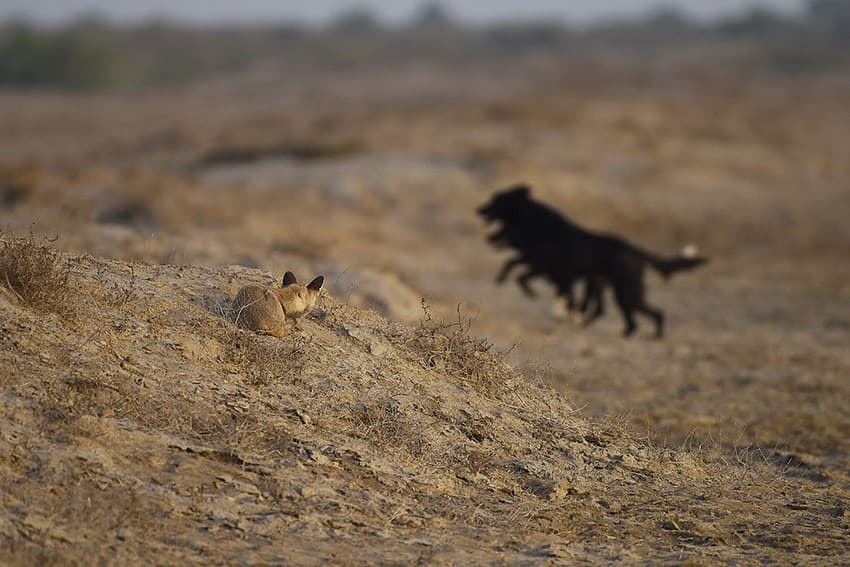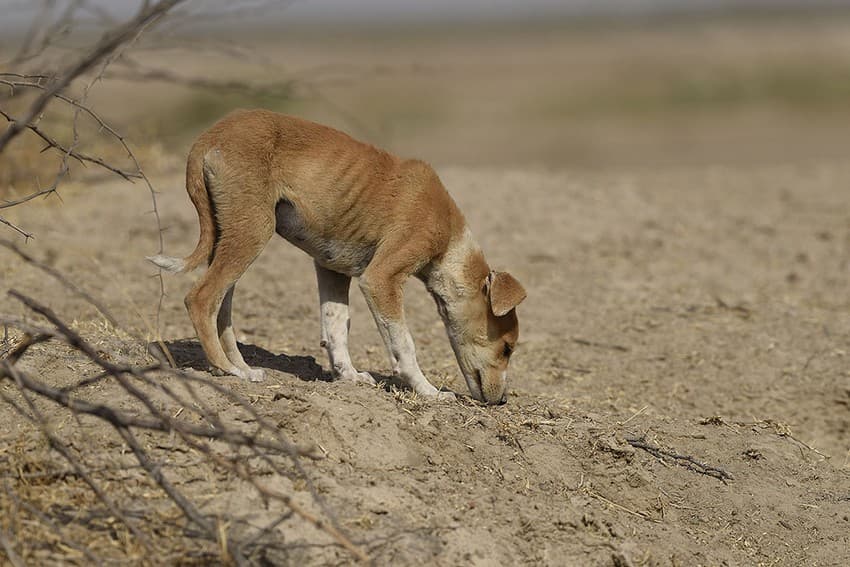Seen here is a desert fox vixen looking intently at two domestic dogs who have come dangerously close to her den in the Indian Wild Ass Sanctuary situated in the Little Rann of Kutchh, Gujarat. Observing the vixen and her pups from a safe distance for over an hour on three consecutive days, I witnessed two different packs of six and five feral dogs respectively, visiting the den site with the sole purpose of attacking the pups. I sighted three pups on the first morning but on subsequent visits only two. The vixen too would get extremely stressed as soon as she spotted the dogs even from a distance of 500+ metres. Probably, one of the pups had fallen prey to those dogs.

A lone desert fox keeps an intent watch from his hidden crouch as feral dogs on the hunt pass by. Photo: Anish Andheria

A dog standing over the den of the desert fox and sniffing for telltale signs of the pups. Photo: Anish Andheria
Research across the globe has unequivocally shown that despite providing some benefits to humans, domestic dogs, classified as owned dogs, street or free living dogs, and feral dogs, have many negative impacts on biodiversity, particularly due to interactions such as competition, predation and pathogen transmission with native wildlife.
Dogs have been associated with humans for more than 33,000 years and the current global population of domestic dogs is estimated at close to 750 million. India harbours a large feral dog population inside and outside Protected Areas due to the presence of humans there. These dogs occasionally feed on resources offered by humans, but are not entirely dependent on them. A significant proportion of their food comes from birds, reptiles and their eggs, small mammals such as rodents and squirrels, large mammals such as deer and antelope, and from scavenging at garbage dumps or animal carcasses.
Domestication may have instilled certain behaviour responses when prompted by rewards such as petting, play or food; however dogs are easily excitable like their wild ancestors when exposed to wildlife, developing greater hunting abilities by forming packs. They usually chase and capture other species for fun. Their presence is a threat to biodiversity and needs to be urgently treated with effective management actions. Populations of several species such as the Black-necked and Sarus Cranes, the Great Indian Bustard, both Indian and desert foxes, monitor lizard and other ground-dwelling lizards such as the spiny-tailed lizard, Himalayan brown bears, blackbuck, wolves, jackals, sambar and chital deer are under severe threat due to depredation by or competition with dogs. Additionally, dogs are potential vectors of distemper, parvovirus and rabies, threatening more native vertebrate populations than one can imagine.
Domestic dogs threaten wildlife throughout India – from the lofty Himalaya to the most inaccessible and hostile landscapes such as deserts and mangrove swamps, presenting a great conservation challenge, especially because the solution to this problem is intimately tied to the economic, social and political values of people. Unless a massive national campaign coupled with stringent regulations on movement of domestic dogs is launched in consultation with local communities, time will soon run out for several of our endangered and common wild species.
Sanctuary Asia Editor’s Note: this is a serious problem that can be solved provided species-rights and animal-rights experts work in unison, to the benefit of both wild species and feral dogs.
This article was first published in the Sanctuary Asia magazine, August 2019 issue.
——————————————————————————————————————————————————————
About the Author: President of the Wildlife Conservation Trust (WCT), which is involved in several wildlife conservation projects in central India, Dr. Anish Andheria’s focus research area has been predator-prey relationships. An accomplished naturalist and wildlife photographer, he has authored several scientific papers and books.
——————————————————————————————————————————————————————
Disclaimer: The author is associated with Wildlife Conservation Trust. The views and opinions expressed in the article are his own and do not necessarily reflect the views and opinions of Wildlife Conservation Trust.
Related Links
- Conservation Strategy
- Forensics in Wildlife Crime Investigation
- Parley with the Mind
- Wildlife Trafficking: Here’s What You Should Know
- Past Events
- 9 Steps to an Environment Friendly Lifestyle
- Rediscovery of Eurasian Otter
- Focus on accurate means of wildlife tracking is the need of the hour: Anish Andheria
